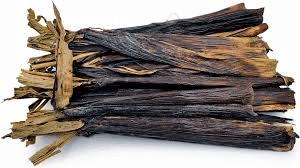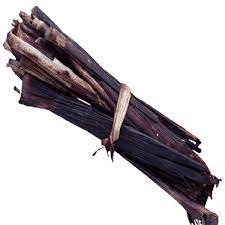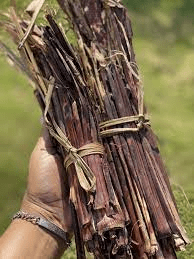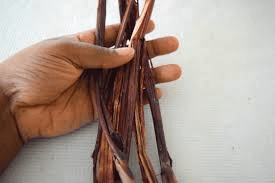Sorghum stalks are the fibrous, upright stems of the sorghum plant, a major cereal crop cultivated worldwide, particularly in regions with hot and dry climates. Sorghum, scientifically known as Sorghum bicolor, belongs to the Poaceae family and is an important staple food and fodder crop. The stalks are crucial for understanding the plant’s structure, growth, and agricultural uses.
Sorghum stalks are typically robust and can reach heights of up to 3.5 meters (11.5 feet), depending on the variety and growing conditions. They have a cylindrical shape and are composed of several distinct sections. The base of the stalk, known as the lower internode, is thicker and often has a more developed vascular system to support the plant’s growth and transport nutrients.
As you move upwards, the stalk gradually becomes slimmer and more flexible. Each internode, or segment of the stalk, is separated by nodes where leaves and branches emerge.
The outer layer of the sorghum stalk is covered in a tough, fibrous rind. This rind provides structural support and protection against environmental factors. The stalk’s internal structure is made up of a series of vascular bundles, which include xylem and phloem tissues. Xylem vessels are responsible for transporting water and dissolved minerals from the roots to the rest of the plant, while phloem transports the products of photosynthesis, primarily sugars, from the leaves to other parts of the plant.
One of the key characteristics of sorghum stalks is their ability to store large amounts of carbohydrates in the form of sugars. This stored energy is crucial for the plant’s growth, especially during periods of stress such as drought or nutrient deficiency. The stalks also play a significant role in the plant’s reproduction. During the flowering phase, the energy stored in the stalks supports the production of seeds and helps in the development of the sorghum panicle, which is the structure where the seeds are formed.
Sorghum stalks are not only important for the plant’s life cycle but also have various applications in agriculture and industry. In many regions, the stalks are used as livestock feed due to their high fiber content and energy value.
After harvesting the grain, the remaining stalks can be processed into silage or used as a bedding material for animals. In some areas, sorghum stalks are also employed in the production of biofuels and as a raw material in the paper and construction industries.
The structural properties of sorghum stalks are influenced by the plant’s genetic makeup and environmental conditions. For instance, sorghum varieties adapted to dry climates often have more fibrous and thicker stalks, which help them conserve water and withstand harsh conditions. Conversely, varieties grown in more temperate climates may have softer and more pliable stalks.
Sorghum stalks are a vital component of the sorghum plant, providing both structural support and storage of essential nutrients. Their complex internal structure, combined with their ability to adapt to different environmental conditions, makes them an integral part of the plant’s growth and utility. Understanding the anatomy and function of sorghum stalks is essential for optimizing their use in agriculture and industry, highlighting their significance beyond mere plant support.
The Economic Importance and Uses of Sorghum Stalks

1. Animal Feed: Sorghum stalks are used as feed for livestock, providing roughage and nutrients.
2. Biofuel Production: Sorghum stalks can be processed into biomass for bioethanol or biogas production, contributing to renewable energy sources.
3. Building Materials: The stalks can be used in the production of eco-friendly building materials such as particleboard and fiberboard.
4. Soil Improvement: When decomposed, sorghum stalks add organic matter to the soil, enhancing its fertility and structure.
5. Erosion Control: The root systems and stalk residues help stabilize soil and prevent erosion.
6. Crafting Materials: Dried sorghum stalks are used in crafting, including making brooms, baskets, and decorative items.
7. Composting: Stalks are excellent for composting, contributing to the creation of nutrient-rich compost.
8. Animal Bedding: The stalks can be used as bedding material for livestock, providing comfort and hygiene.
9. Renewable Energy: Besides biofuel, the stalks can be used to produce heat energy through direct combustion.
10. Green Manure: Plant residues, including stalks, can be used as green manure to improve soil fertility.
11. Biodegradable Materials: Sorghum stalks can be processed into biodegradable packaging materials, reducing environmental impact.
12. Carbon Sequestration: Sorghum stalks contribute to carbon sequestration, helping to mitigate climate change.
13. Pest Control: Extracts from sorghum stalks can be used to create natural pest repellents.
14. Animal Feed Additives: Stalks can be processed into additives for animal feed, providing additional nutrients and fiber.
15. Water Filtration: The stalks can be used in natural water filtration systems to remove impurities.
16. Agroforestry Systems: Sorghum stalks can be integrated into agroforestry systems to support sustainable land management.
17. Natural Adhesives: Stalk extracts can be used to produce natural adhesives for various applications.
18. Green Building Materials: Stalks can be used in the production of sustainable and eco-friendly building materials.
Read Also: Best Number of Ruminant Animals per Housing Unit for Fattening
The Products and By-products That Can Be Derived From Sorghum Stalks

1. Animal Feed: Sorghum stalks can be processed into high-fiber feed for livestock.
2. Bioethanol: Stalks can be used to produce bioethanol through fermentation.
3. Particleboard: Stalks can be used to create particleboard for construction and furniture.
4. Compost: Decomposed stalks contribute to nutrient-rich compost for gardening and farming.
5. Brooms and Brushes: Dried stalks are used to make brooms and brushes.
6. Biodegradable Packaging: Stalks can be processed into biodegradable packaging materials.
7. Natural Pest Repellents: Extracts from stalks are used to create natural pest repellents.
8. Renewable Energy: Stalks can be used to produce heat energy through direct combustion.
9. Green Manure: Stalks can be plowed back into the soil to improve fertility as green manure.
10. Fiberboard: Stalks can be used to make fiberboard for building and construction.
11. Water Filtration Systems: Stalks are used in natural water filtration to remove impurities.
12. Natural Adhesives: Stalk extracts can be processed into natural adhesives.
13. Building Materials: Stalks can be used to create eco-friendly building materials.
14. Animal Bedding: Stalks can be used as bedding material for livestock.
15. Biochar: Stalks can be processed into biochar for soil improvement and carbon sequestration.
16. Nutrient Additives: Processed stalks can be added to animal feed as a source of nutrients and fiber.
17. Green Building Materials: Stalks are used in the production of sustainable construction materials.
Read Also: Common Rabbit Diseases and How to Cure them
Frequently Asked Questions (FAQ’s) About Sorghum Stalks

1. What are sorghum stalks used for?
Sorghum stalks are used for animal feed, biofuel production, building materials, soil improvement, and crafting.
2. Can sorghum stalks be used as animal feed?
Yes, sorghum stalks are used as high-fiber feed for various livestock.
3. How do sorghum stalks contribute to soil health?
When decomposed, sorghum stalks add organic matter to the soil, enhancing its fertility and structure.
4. Can sorghum stalks be used in biofuel production?
Yes, stalks can be processed into biomass for bioethanol or biogas production.
5. Are sorghum stalks useful in crafting?
Yes, dried stalks are used to make brooms, baskets, and decorative items.
6. How do sorghum stalks help with erosion control?
Sorghum stalks and their root systems help stabilize soil and prevent erosion.
7. Can sorghum stalks be used for renewable energy?
Yes, stalks can be used to produce bioethanol or heat energy through direct combustion.
8. Are sorghum stalks beneficial for composting?
Yes, stalks are excellent for composting, contributing to the creation of nutrient-rich compost.
9. How do sorghum stalks contribute to carbon sequestration?
Sorghum stalks help capture carbon dioxide from the atmosphere, aiding in climate change mitigation.
10. Can sorghum stalks be used in natural pest control?
Yes, extracts from sorghum stalks can be used to create natural pest repellents.

